| After the launch, guests were invited to
visit exhibition booths to learn more about
People and Plants Online (the Website of the
People and Plants Initiative), WWF Malaysia,
Natural History Publications and a Kadazandusun
Medicinal Plant Manual. Dr. Gary J. Martin,
author of the manual, signed and distributed over
150 copies of Etnobotani to guests at the launch.
People and Plants in Southeast Asia and WWF
Malaysia plan to distribute 1850 additional
copies of the manual in Malaysia, Indonesia,
Brunei and Singapore. The press release
and speeches for the launch are presented
below.
Etnobotani book
launched in Kota Kinabalu
Datuk Wilfred Bumburing, Minister
of Culture, Environment and Tourism, launched the
book Etnobotani in Kota Kinabalu today. Also
participating in the event were Tengku Datuk Dr.
Zainal Adlin, trustee of the World Wide Fund for
Nature Malaysia, and Chan Chew Lun, managing
director of Natural History
Publications.
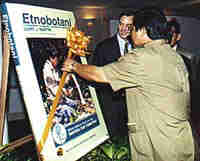 |
Y.B.Datuk Wilfred
Bumburing cutting the
ribbon on "Etnobotani" model to
launch the manual, as Gary martin looks
on. |
Co-published by
the World Wide Fund for Nature and Natural
History Publications, the book was written in
English by Dr. Gary J. Martin, an ethnobotanist
who received his education at the University of
California, Berkeley in the United States.
Associate Professor Maryati Mohamed of the
Universiti Malaysia Sabah translated the work
into Bahasa Malaysia, making the manual
accessible to students, researchers and
conservationists in Malaysia, Indonesia, Brunei
and Singapore.
| Dius
Tadong of Takuton explaining the
production of the Kadazandusun Medicinal
Plant Manual to Datuk Wilfred Bumburing
as Alan Hamilton and Y.B Tengku Datuk Dr.
Zainal Adlin looks on. |
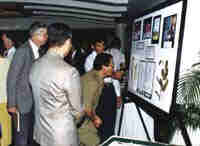 |
Etnobotani,
which is designed to be a field methods manual
and a university textbook, contains chapters on
botany, anthropology, ecology, phytochemistry,
linguistics and economics, as they relate to the
study of the relationships between people and
plants. In addition, there is an introductory
chapter on research design, and a final chapter
on applying ethnobotany to conservation and
community development.
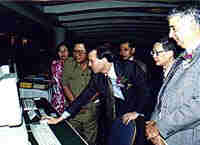 |
“I am pleased that a Bahasa
Malaysia version of the Ethnobotany
Methods Manual is available”, said
Dr. Martin. “I wrote the manual for
use by students and researchers involved
in grassroots conservation and community
development projects, and the translation
will make the book more accessible to
Malaysians, Indonesians and other people
in Southeast Asia.” He added that
Chinese and Spanish editions are under
preparation.
|
| Dr. Martin is the Southeast Asia
regional coordinator for the People and
Plants Initiative, an international
programme of WWF, the United Nations
Educational, Scientific and Cultural
Organization (UNESCO), and the Royal
Botanic Gardens, Kew. |
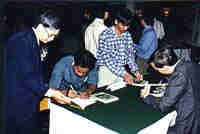 |
In a speech that opened the launch,
Chan Chew Lun explained that ethnobotany
“is broadly defined as the
relationship between people and
plants”. Furthermore, he stated
“As a science, ethnobotany
encompasses a multi-disciplinary approach
that requires study not just of plants
alone, but of people, culture and
circumstances at the same
time.” |
Datuk Bumburing drew attention to the
broad importance of ethnobotany in Sabah, a state
known for its ecological and cultural diversity.
“I am very pleased to stress to you
that ethnobotany – studying the
relationships between people and plants and
showing their importance to conservation and
development – is greatly welcomed by my
Ministry”, he said. “Conserving
Southeast Asia’s forests and promoting
traditional knowledge are challenges that face
all of us, especially in these days of rapid
economic and social change.”
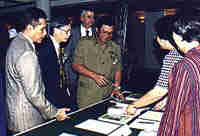 |
Tengku Adlin, speaking in his
capacity as trustee of WWF Malaysia,
noted, “One important lesson that I
have drawn from Etnobotani and the wider
People and Plants Initiative is that
ethnobotanical research must be designed
and carried out jointly with community
members. The benefits and results of
these studies must be shared on an
equitable basis with local people and
colleagues throughout the world.” |
He added, “There are many
ways of achieving this, such as producing
educational materials in local languages,
promoting the sustainable management of plant
resources, disseminating information through the
Internet, and encouraging the use of rigorous
scientific and participatory methods as we carry
out research.”
The People and Plants in Southeast Asia programme
and WWF Malaysia will distribute Etnobotani to
selected individuals in universities,
non-government organizations and government
agencies who are studying the relationship
between people and their environment. Copies are
also available from Natural History Publications
(Borneo) Sdn. Bhd.
TOP
Speech by C.L.
Chan, Managing Director of Natural History
Publications (Borneo) Sdn. Bhd.
 YB
Datuk Wilfred Bumburing, the honorable Minister
of Culture, Environment and Tourism, Puan Monica
Chia, Permanent Secretary to the Ministry, YB
Datuk Wilfred Bumburing, the honorable Minister
of Culture, Environment and Tourism, Puan Monica
Chia, Permanent Secretary to the Ministry,
Dr. Noh, Deputy Vice Chancellor of Universiti
Malaysia Sabah; Mr. Francis Liew, Deputy Director
of Sabah Parks; Mr. Chan Chew Lun, managing
director of Natural History Publications; Dr.
Isabelle Louis, director of conservation of WWF
Malaysia; Dr. Alan Hamilton, Plants Conservation
Officer of WWF International; Dr. Gary J. Martin,
regional coordinator of People and Plants in
Southeast Asia, Datuk Datuk, Datin Datin, Ladies
and Gentlemen,
It is with the greatest honour that we have
with us today YB Datuk Wilfred Bumburing, the
Honorable Minister of Culture, Environment and
Tourism of Sabah, to grace an occasion that many
of us will agree is quite special. For
today’s launching is of a book that
addresses an issue close to all of us in
Sabah.
Ethnobotany, broadly defined as the
relationship between people and plants, uses of
plants, culture and plants, or our past, present
and future with plant resources, spells out the
intimate connections between civilizations and
plants of the sort that generations of the
peoples of Sabah are familiar with. It has been
said that “plants are the foundation of
human existence” and there is much living
evidence of the very many interesting ways that
plants are used in the colourful cultures of
Sabah and neighbouring areas.
Especially exciting is the fact that Sabah,
and Borneo, are within a tropical setting where
the diversity of its living resources is
exceptionally high. There may be as many as
10,000 to 12,000 species of plants in Borneo, and
evidence has it that a sizeable share of this is
found in Sabah. Thus, a relationship between
plants and people that is just as diverse, and as
complex as we can imagine, exists here in our
very state.
Yet as a science, ethnobotany encompasses a
multi-disciplinary approach that requires a study
not just of plants alone, but of people, culture
and circumstances at the same time. Gone are the
days when ethnobotany basically only spells out
the kinds of uses that plants are put to. How
diverse are the plant resources available to a
community? How are certain plants and materials
special for particular needs and how widespread
is a particular pattern of use? What effect do
certain ways of utilisation have on plant
populations, in terms of their survival and
conservation? What scientific bases are there of
the use of certain plant materials? Ethnobotany
today is involved with not just the persistence
of cultures, but also the diminishment of
cultures and the ecology of the relationship
between people and plants.
Even more remarkable is the possibility now
for the compilation of manuals to the study of
ethnobotany. One has even been written in 1995
that particularly addresses the context of
species-rich, culturally diverse tropical
environments. The author of this manual is Dr
Gary Martin, regional coordinator of People and
Plants in South East Asia. This program focuses
on community-based ethnobotanical research, to
identify ways in which communities might have an
input into development and management plans for
the lands and biological resources they
traditionally use. The programme, now into its
second phase running from 1996 to 2000, works by
building collaboration between communities,
researchers, conservation personnel,
environmental organizations and government
agencies.
Now there is, in addition to the original
edition, a version in Bahasa Malaysia, which will
find wider distribution and use among students in
Malaysia and even Indonesia. This translation was
effected by Associate Professor Dr. Maryati
Mohamad of the University Malaysia Sabah, as part
of its programme to make available more
literature resources for subjects of current
importance and relevance.
Manuals have to be easy to use but they are
often difficult to write. The vast experience of
Dr Gary Martin has no doubt been of primary
importance, but what is equally notable is the
foresight of Sabah Parks in hosting a key
component of the People and Plants Initiative,
which has found avenue in the Projek Ethnobotani
Kinabalu or “PEK”. The Projek
Etnobotani Kinabalu is ethnobotany at work, in
which the rich traditions of plant use are
subjected to systematic survey, documentation and
interpretation through collaboration between
members of the communities, scientists and
resource managers. This perspective is now being
extended outside of Kinabalu, a testimony to its
growing importance.
YB Datuk, it is my great pleasure to welcome
you to today’s special event to celebrate
the publication of “Etnobotani”. This
book represents the commitment of Dr Gary Martin,
working with key persons in Sabah’s resource
departments and university, towards underscoring
the importance of systematic study of the
relationship between people and plants.
“Etnobotani” is, by itself, a clear
example of the need to popularise various
underlying concepts that are crucial to resource
management: that as many facets of resource
utilisation and potential need to be
systematically understood and documented, and
that this view must encompass the different major
stakeholders, in order that conservation and wise
management may benefit from the knowledge
gathered.
YB Datuk, it is the utmost significance that
you are here with us today and with the greatest
pleasure we record our appreciation for your keen
interest and continuing support for this work. As
the publishers, it is the fervent hope of Natural
History Publications that more effort will find
expression as this Manual has found, and that our
efforts towards building scientific and
educational resources will continue to receive
your wise patronage.
TOP
Speech by Y.B
Tengku Datuk Dr. Zainal Adlin
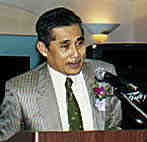 Yang
Berhormat Datuk Wilfred Bumburing, Minister of
Culture, Environment and Tourism; Puan Monica
Chia, Permanent Secretary of the Ministry of
Culture, Environment and Tourism; Dr. Noh, Deputy
Vice Chancellor of Universiti Malaysia Sabah; Mr.
Francis Liew, Deputy Director of Sabah Parks; Mr.
Chan Chew Lun, managing director of Natural
History Publications; Dr. Isabelle Louis,
director of conservation of WWF Malaysia; Dr.
Alan Hamilton, Plants Conservation Officer of WWF
International; Dr. Gary J. Martin, regional
coordinator of People and Plants in Southeast
Asia. Yang
Berhormat Datuk Wilfred Bumburing, Minister of
Culture, Environment and Tourism; Puan Monica
Chia, Permanent Secretary of the Ministry of
Culture, Environment and Tourism; Dr. Noh, Deputy
Vice Chancellor of Universiti Malaysia Sabah; Mr.
Francis Liew, Deputy Director of Sabah Parks; Mr.
Chan Chew Lun, managing director of Natural
History Publications; Dr. Isabelle Louis,
director of conservation of WWF Malaysia; Dr.
Alan Hamilton, Plants Conservation Officer of WWF
International; Dr. Gary J. Martin, regional
coordinator of People and Plants in Southeast
Asia.
I have been given this honor as a trustee of
WWF Malaysia to say a few words for the launch of
the People & Plants Etnobotani manual , a
joint initiative of WWF, the United Nations
Educational, Scientific and Cultural Organization
(UNESCO) and the Royal Botanic Gardens at Kew,
England.
We have all long since recognised the
importance of recording our cultural knowledge of
the natural world, and ensuring that our
knowledge continues to be a living tradition. To
achieve this ambitious goal, we must provide
training for people from many different
countries, disciplines, regions and backgrounds.
The manual - Etnobotani will contribute to this
important objective. It is a basic text on
ethnobotanical techniques and tools that can be
used in research, conservation and development
projects throughout Malaysia, Indonesia,
Singapore and Brunei.
Written in Bahasa Malaysia, Etnobotani will be
accessible to a wide range of people across the
region - to students, protected areas staff,
community representatives, NGO members and many
others. It is the beginning of our work together
to explore innovative methods of promoting
sustainable use of plant resources and
reinforcing local knowledge of our natural world.
This
approach is critical, as we cannot afford to lose
any more time in our struggle to maintain
resources and knowledge in the community as
lifestyles and natural areas of our region
undergo rapid change
People and Plants provides access to
information and training on ethnobotany,
conservation and development for colleagues
throughout Southeast Asia and other parts of the
world. It collaborates closely with WWF Malaysia
and other national
institutions on various community-based projects
in Sabah. These initiatives form part of a new
generation of projects in which WWF Malaysia
emphasises integrating community members in
conservation projects. In various areas of the
state, we are promoting sustainable and wise use
of plants and animals, ensuring that local
ecological knowledge is available for future
generations.
Through these projects, WWF Malaysia is
continuing to develop a strong and supportive
relationship with the Sabah Government, in
particular the Ministry of Culture, Environment
and Tourism, Sabah Parks, Sabah Wildlife
Department and the Forest Research Centre of the
Sabah Forestry Department. We are also
collaborating with many other partners, such as
PACOS and the Kadazandusun Linguistic Foundation,
local non-government organisations that are
working on common goals. Our network of
collaboration extends to ecotourism companies
such as Kinabalu Gold Resorts and Wildlife
Expeditions, which have given valuable support to
various People and Plants activities around
Kinabalu Park.
Representatives of all these institutions are
increasingly aware of the importance of linking
knowledge, traditions and environment in
promoting tourism and other types of economic
development. This is particularly critical in
biologically and culturally rich areas such as
Sabah.
Ladies and Gentlemen:
I would like to extend my thanks to the
sponsors of the People and Plants Initiative who
have supported the publication of Etnobotani.
These include the John D. and Catherine T.
MacArthur Foundation in the United States, the UK
Department for International Development, the UK
National Lotteries Charity Board and the European
Union. Further, I would like to applaud the
efforts of the author of the manual, Dr. Gary
Martin, and his colleagues in People and Plants
who first proposed a Bahasa Malaysia edition of
the Ethnobotany Methods Manual. I would also like
to gratefully acknowledge the efforts of
Associate Professor Maryati Mohamed, who
supervised the translation, and Chan Chew Lun,
who published Etnobotani in collaboration with
WWF.
I would like to say a word on Chan Chew Lun,
for those of you who do not know him. He is a
naturalist, author and publisher par excellence,
recognised for the high quality of his
publications on flora and fauna. Even the Royal
Botanic Garden, Kew deems fit to publish in
Malaysia due to the excellent quality of the
publications. He is a gold medal winner, not in
the Commonwealth Games, but in the world of
publishing.
One important lesson that I have drawn from
Etnobotani and the wider People and Plants
Initiative is that ethnobotanical research must
be designed and carried out jointly with
community members. The benefits and results of
these studies must be shared on an equitable
basis with local people and colleagues throughout
the world. There are many ways of achieving this,
such as producing educational materials in local
languages such as Kadazandusun, promoting the
sustainable management of plant resources,
disseminating information through the Internet,
and encouraging the use of rigorous scientific
and participatory methods as we carry out
research.
My friends,
Please take the opportunity to visit the
exhibition booths in this ballroom to learn of
the innovative ways in which People and Plants,
WWF Malaysia and their partners are applying
these approaches in Sabah.
You will be able to browse through the People
and Plants Online Website, an international
Internet service that has been designed and
produced here in Sabah by RAM Production Sdn.
Bhd., and hosted in the Royal Botanic Gardens,
Kew server. The Website contains information on
the People and Plants manuals, working papers,
handbooks and videos, and provides links to many
other organisations worldwide that are involved
in conservation and development. In a more
localised context, the Website provides news and
information on the various People and Plants
field projects that are conducted here in
Sabah.
You will also have the opportunity to leaf
through a Kadazandusun medicinal plant manual,
published jointly by WWF Malaysia and Sabah
Parks. This is one result of many years of hard
work by the Projek Etnobotani Kinabalu team,
which consists of Dusun-speaking park personnel
who have been working since 1992 with People and
Plants and many community members from around
Kinabalu Park. Many of these community members,
who provided the information contained in the
manual, are present at this launch and will be
pleased to discuss their efforts with members of
the press and public.
I would also like to recognize the presence of
community members from various kampongs. [Note:
In Bahasa Malaysia, Tengku Adlin asked the
community members to stand, and he recognised
them for their efforts]. Without them, I do not
think that you would be able to produce this type
of ethnobotany manual.
Also for your information, Dr. Gary Martin,
the author of Etnobotani, will be signing copies
of the manual, which will be available free of
charge to colleagues who feel that it will be
useful in research, teaching or studies. The
co-publisher of this manual, Mr. Chan Chew Lun,
has set up an exhibit on Natural History
Publications where you can see many other books
on the plants, animals, protected areas and
indigenous cultures of Sabah.
Finally, WWF Malaysia has prepared a display
that will acquaint you with the activities that
we are sponsoring not only in Sabah but also
throughout the country. WWF has been working in
Sabah since 1972, and one of its first projects
was working on a marine study in Gaya Island near
Kota Kinabalu.
In closing, I would like to encourage all of
you who do receive a copy of Etnobotani to put it
to good use in a united effort to document and
promote Sabah's rich heritage of biological
resources and traditional ecological knowledge.
These are treasures that we should guard and
develop for future generations.
TOP
Speech by Y.B.
Datuk Wilfred Bumburing, Minister of Culture,
Environment and Tourism
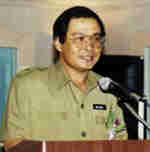
Good morning.
Yang Berhormat Datuk Wilfred Bumburing,
Minister of Culture, Environment and Tourism;
Puan Monica Chia, Permanent Secretary of the
Ministry of Culture, Environment and Tourism; Dr.
Noh, Deputy Vice Chancellor of Universiti
Malaysia Sabah; Mr. Francis Liew, Deputy Director
of Sabah Parks; Mr. Chan Chew Lun, managing
director of Natural History Publications; Dr.
Isabelle Louis, director of conservation of WWF
Malaysia; Dr. Alan Hamilton, Plants Conservation
Officer of WWF International; Dr. Gary J. Martin,
regional coordinator of People and Plants in
Southeast Asia.
Before I begin this morning, please allow me
to say thank you very much for giving me this
opportunity to launch this special educational
book - Etnobotani. I am very pleased to
stress to you that ethnobotany, that is, studying
the relationships between people and plants and
showing their importance to conservation and
development – is greatly welcomed by my
Ministry.
Conserving Southeast Asia’s forests and
promoting traditional knowledge are challenges
that face all of us, especially in these days of
rapid economic and social change. Sabah, like
many areas around the world, is facing many
cultural and ecological challenges. In the course
of a few decades, we are in danger of losing the
plant and animal diversity on which we depend.
Over a few generations, the traditional botanical
knowledge that local communities have built up
over several millennia is slipping away. And in
academia, we are failing to train enough
qualified professionals who can seek solutions to
these problems in collaboration with government
agencies, local communities and the general
public. The publication of Etnobotani and other
efforts by the People and Plants Initiative are
valuable contributions to reversing these
trends.
Ladies and Gentlemen:
Although the term ethnobotany may sound new to
many people – including me – I can
assure you that it is an integral part of many
government programs in Sabah. The most notable
example is the Projek Etnobotani Kinabalu, known
as the PEK, which was launched in 1992 by Sabah
Parks and the People and Plants Initiative. This
project focuses on promoting the sustainable use
of forest resources around Kinabalu Park and
Crocker Range Park, ensuring the continuity of
local ecological knowledge of Kadazandusun and
other ethnic communities. One of the exhibition
booths in this ballroom displays the most recent
output of the PEK: a manual written primarily in
the Dusunic dialect, which describes the
medicinal uses of plants commonly found in the
communities around Kinabalu Park. The success of
this project is due in large part to the efforts
of the PEK research team, based in Kinabalu Park,
and hundreds of participants from Kadazandusun
communities. I am pleased to see many of the key
players in this project with us today, and I
would like to welcome them with a few words in
our common language [Note: Datuk Bumburing
addressed the members of communities in
Kadazandusun for several minutes].
Let me take this opportunity to congratulate
Sabah Parks on sponsoring the PEK, which is a
vital section of the Research and Education
Division. I would like to encourage Sabah Parks
to continue prioritising ethnobotany along with
botany, entomology, zoology and other
disciplines.
Far from being the only ethnobotanical project
in the state, the PEK stands alongside
significant efforts of other agencies, for
example,
(1) In recognising the importance of
non-timber forest products, the Forest Research
Centre in Sandakan is documenting valuable forest
resources that can provide supplemental income to
communities.
(2) the Sabah State Museum has for many years
been active in documenting the plants used by
many ethnic groups of Sabah. Countless school
children have visited the traditional houses and
gardens at the Museum that provide an attractive
and compelling display of the diversity of plant
resources available to us.
(3) the Agriculture Department maintains a
rich collection of native fruit trees at the
agricultural park and research station in Tenom.
This and other germplasm collections are a
valuable resource for local farmers who wish to
maintain Sabah’s diverse and bountiful
agricultural production.
I should add that many academic,
non-government and community organisations have
launched ethnobotanical projects, and their
efforts are bearing fruit today.
Ladies and Gentlemen:
In the perspective of the government of Sabah,
we feel that it is critical to institutionalise
these initiatives, ensuring that short-term
ethnobotanical projects become a permanent part
of Sabah’s drive towards economic
development. As a state that has always relied
heavily on its natural heritage, it is essential
that we maintain the diversity of resources used
in subsistence and commerce.
Apart from providing models for the
appropriate management of critical habitats, we
need an ethnobotanical approach to help us
formulate government policies. Even as
researchers and communities pursue innovative
approaches at the local level, we require
effective state, national and regional
legislation that protect the intellectual
property rights of our citizens and regulate the
commercialisation of the biological treasures of
our state. All of us – government officers,
members of non-government organisations,
academics and community representatives –
must seek to ensure that bioprospecting,
ecotourism and other ways of making money from
the environment do not kill the goose that lays
the golden egg.
In this context, I was pleased to learn of a
recent series of events that address these
critical issues. In late August, Partners of
Community Organisations (PACOS), a Sabah-based
non-government organisation, conducted a workshop
on “community protocols” held at the
Majora Holiday Farm near Kampung Bundu Tiga,
Tambunan. Earlier this week, the People and
Plants Initiative and the Universiti Malaysia
Sabah sponsored a seminar on “Biodiversity
Prospecting: Access, Control and Benefit
Sharing”. Over the last two days, the PEK
team and many of the community members
responsible for producing the Kadazandusun
medicinal plants manual participated in a
workshop on “Community Research
Agreements”, held at Mesilau Nature Resort.
All three events have brought to our attention
the importance of creating memoranda of
understanding between communities, governmental
agencies, academic institutions and other
participants in ethnobotanical research
projects.
Ladies and gentlemen:
As you can see from these brief examples, the
Sabah government has recognised the value of
developing viable ethnobotanical research
programs in collaboration with communities.
Although some people may feel that modernisation
means turning our back on traditional lifestyles,
projects like the ones I have described show that
traditions are essential to our future. In
closing, I would like to join with Tengku Adlin
and Chan Chew Lun in thanking the various
sponsors of Etnobotani, which I would now like to
launch officially.
Thank you.
TOP
|